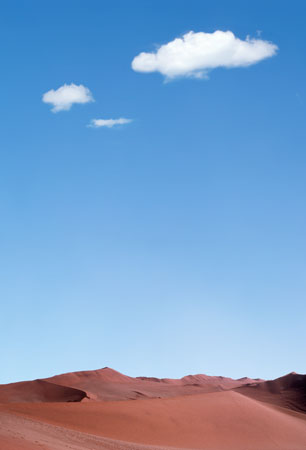Plans to visit deserts are often greeted by surprise. What is the point? Surely there is nothing there! In reality, of course, there are countless wonderful photographic subjects. However, the desert environment is perhaps one of the clearest demonstrations of the need, when exploring the world, to carry beauty with you.
 Deserts are not only hostile for human beings but also for photographic equipment. They are, by definition, very dry but may also be extremely hot or cold. When the sun is overhead temperatures can reach 50C but at night they may plunge below freezing point. Clearly it is important to be properly dressed and to protect oneself from sunburn and dehydration. It is also essential to take local advice, and perhaps a local guide, before venturing into unknown areas where it is all too easy to get lost or bogged down in sand. Spiteful insects and venomous snakes are also potential hazards so think carefully before exploring cool dark places such as those found under rocks. Finally, watch the cactus spines. Nature designed them to keep you at a distance, and they are painfully effective.
Deserts are not only hostile for human beings but also for photographic equipment. They are, by definition, very dry but may also be extremely hot or cold. When the sun is overhead temperatures can reach 50C but at night they may plunge below freezing point. Clearly it is important to be properly dressed and to protect oneself from sunburn and dehydration. It is also essential to take local advice, and perhaps a local guide, before venturing into unknown areas where it is all too easy to get lost or bogged down in sand. Spiteful insects and venomous snakes are also potential hazards so think carefully before exploring cool dark places such as those found under rocks. Finally, watch the cactus spines. Nature designed them to keep you at a distance, and they are painfully effective.
Camera equipment must be protected from high temperatures. The direct overhead sun can overheat and damage film very quickly. For the same reason do not leave camera bags on hot sand – its sun-baked surface can be too hot to touch. Store temperature-sensitive items in a white polystyrene cooler shaded inside a well-ventilated vehicle. Where possible, keep valuable items in sealed plastic bags to protect them from the damaging abrasive effects of small particles of wind-blown sand. This is a particular problem when travelling, and on the lee side of dune ridges where fine sand is constantly on the move. When working away from a vehicle, keep camera and lens inside disposable plastic bags that can be removed quickly.
Deserts are best photographed early in the morning and late in the afternoon when the sun is at a low elevation and shadows are long. The low-angle light warms the colours of the sand and also reveals the form and texture of sand formations. Try to capture not only the beautiful curving shapes of the large nomadic dunes but also the small rippling patterns found in their surfaces. Small isolated plants provide scale and can make interesting points of interest in compositions designed to portray the harshness of the barren landscape. Take care not to walk in areas you intent to photograph because footprints cannot be easily erased. In extreme desert environments the subject matter becomes more abstract. Elements of composition are shape, texture, colour, simplicity and desolation. Each one of these is beautiful in its own right but when all are combined into a single image the result can be stunning.
Sand, like snow, causes a high level of reflection. In deserts, where sand occupies a large part of the field of view, reflected light may lead to significant underexposure if reliance is placed upon automatic exposure measurements. When the sun is low the problem is less severe but, as it rises, the sand becomes glaringly bright. Under these conditions it is best to bracket exposures, perhaps overexposing by as much as one stop.






